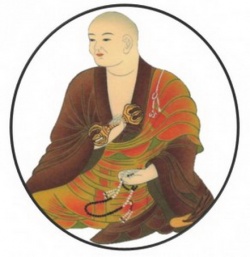Kobo
Kobo
[弘法] (774–835)
Also known as Kukai. The founder of the True Word (Shingon) school in Japan. His posthumous honorific name and title are the Great Teacher Kobo. A native of Sanuki Province in Shikoku in southern Japan, he went to Nara in 788 and studied the Chinese classics, including Analects by Confucius, under the Confucian scholar Ato no Otari, his maternal uncle. In 791 he entered the Confucian college at Naraand continued his study of the Chinese classics. Around that time, a priest (Gonso according to one view) taught him the Esoteric Buddhist practice of chanting a certain mantra one million times with belief in Bodhisattva Space Treasury. This practice, it was said, would enable one to understand all the Buddhist teachings and memorize all the sutras. Kobo devoted himself to this practice. After this, he was ordained a Buddhist priest by Gonsoin 793. In 797 he wrote The Essentials of the Three Teachings, proclaiming the superiority of Buddhism over Taoism and Confucianism.
In 804 Kobo traveled to China and studied Esoteric Buddhism at Ch'ang-an under Hui-kuo. Hui-kuo schooled him in the esoteric doctrines of the Womb Realm and the Diamond Realm, gave him the name Universal Illumination and Diamond, and qualified him to transmit the secret doctrines. In 806, the year after Hui-kuo's death, Kobo returned to Japan, bringing with him copies of the two mandalas of Esoteric Buddhism, esoteric scriptures, and ritual prayer implements. After his arrival, he stayed at Kanzeon-ji temple in Chikuzen Province and elsewhere, and then went to the capital, Kyoto. In 810 he was appointed the chief priest of Todai-ji temple in Nara, and in 816 the imperial court granted him Mount Koya in Kii Province. There he built Kongobu-ji temple and devoted himself to the dissemination of Esoteric Buddhism. In 823 the imperial court presented him with To-ji temple in Kyoto, which he made into a center for the study and practice of Esoteric Buddhism. His works include A Comparison of Exoteric and Esoteric Buddhism, The Doctrine of Attaining Buddhahood in One's Present Form, and The Treatise on the Ten Stages of the Mind. Kobo was also an accomplished calligrapher.
